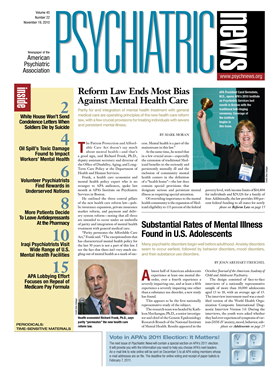A good guide can lead us through an impenetrable thicket, but which guide should we choose from those standing ready at the head of the trail?
Equally, treatment guidelines are intended to help clinicians select the appropriate treatment for their patients, but multiple guidelines for the same condition can create confusion instead of clarity.
So 10 co-authors, all veterans of guideline development for posttraumatic stress disorder (PTSD), have offered a guidebook to the forest by explaining a little something about each of the trees.
“[I]t is wise to first consider interventions for which good evidence does exist ... such that the research evidence is carefully interpreted and translated to ensure its appropriate application to routine clinical care,” wrote the authors in the Journal of Traumatic Stress, published online September 13. They were led by David Forbes, Ph.D., an associate professor at the University of Melbourne and clinical director of the Australian Centre for Posttraumatic Mental Health.
Forbes and his team discussed seven clinical practice guidelines available for PTSD. They included guides from APA, the International Society for Traumatic Stress Studies (ISTSS), the American Academy of Child and Adolescent Psychiatry (AACAP), the U.K. National Institute for Health and Clinical Excellence, Australia's National Health and Medical Research Council, and a combined Veterans Affairs/Department of Defense standard. A seventh document, an assessment of evidence from the U.S. Institute of Medicine (IOM), is not strictly a guideline, but was included because of its widespread influence.
“Our goal was to help clinicians of all disciplines understand why we need guidelines, what they comprise, and how they can be helpful to them in their clinical practices, in research, and in creating public policy across the world,” said co-author Terence Keane, Ph.D., director of the Behavioral Science Division at the National Center for PTSD in White River Junction, Vt., and a professor of psychiatry at Boston University School of Medicine, in an interview. “It was also to assist people in understanding why there might be discrepancies or inconsistencies among the extant guidelines.”
“The guidelines differ, but there is an overarching theme,” said David Spiegel, M.D., a professor of psychiatry and behavioral science at Stanford University School of Medicine and a member of the PTSD subgroup of the anxiety disorders work group for DSM-5. He was not involved in the survey of the guidelines.
Most of the guidelines conclude that there is some benefit in using medications—usually SSRI antidepressants—and in providing a structured environment to work through the effects of trauma, but the specifics differ.
The IOM's report, however, said that there was not enough evidence to support the use of SSRIs. None recommend the use of psychological debriefing.
“Theoretically, there ought to be an absolute gold standard, but it all depends on what you define as gold,” said Spiegel in an interview.
“Where differences exist, they are often a matter of degree,” wrote Forbes and co-authors. “In general, they relate to the strength of recommendation rather than fundamental differences in what is, or is not, recommended.”
Thus, each guideline begins by reflecting the constituency that commissioned it or drew it up. APA's guideline reflects the view of psychiatrists; AACAP's that of child and adolescent psychiatrists in particular; the IOM's that of the VA system, which requested the study; and so on.
Another way to evaluate a guideline is by how it assigns a level of rigor to the evidence under consideration. A third avenue is the strength of the recommendation in favor of a particular treatment.
So, for instance, SSRIs were acceptable first-line interventions in APA's and the VA/Department of Defense guidelines, but they failed to meet the IOM's stricter evidentiary standards because of what the IOM saw as deficiencies in study design.
The ISTSS guidelines, intended for a wider tent of practitioners, is less clear in its priority of recommendations, according to Forbes.
The authors concluded that many recommendations lack sufficient empirical evidence, but that is no reason for clinicians to throw up their hands. Guideline producers should present their work in a form that helps practitioners “easily differentiate which recommendations are evidence based and which are based on clinical consensus, as well as which are informed by the service system and which are independent of service systems.”
Developing better guidelines will depend on more and more rigorous research, with regular updating based on reviews of new evidence.
In the meantime, researchers and clinicians will have to read these Baedekers according to their own clinical traditions and their patients' individual needs.
“Guidelines are just that, guidelines,” said Spiegel. “We try to draw from the best we know, but our assumptions influence our results.”
